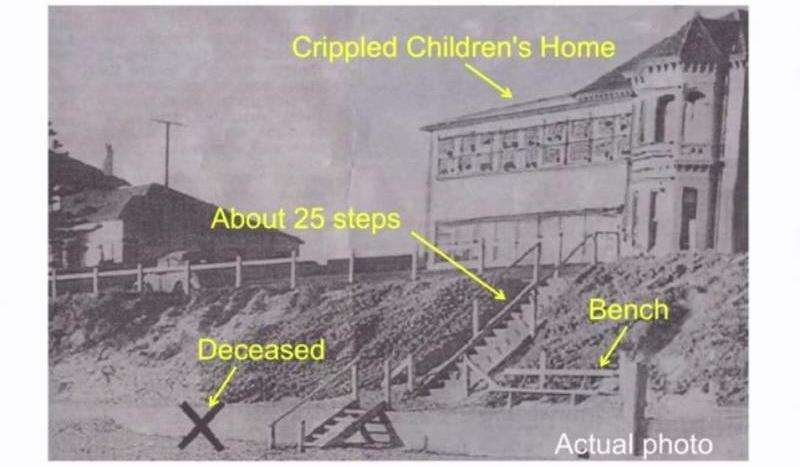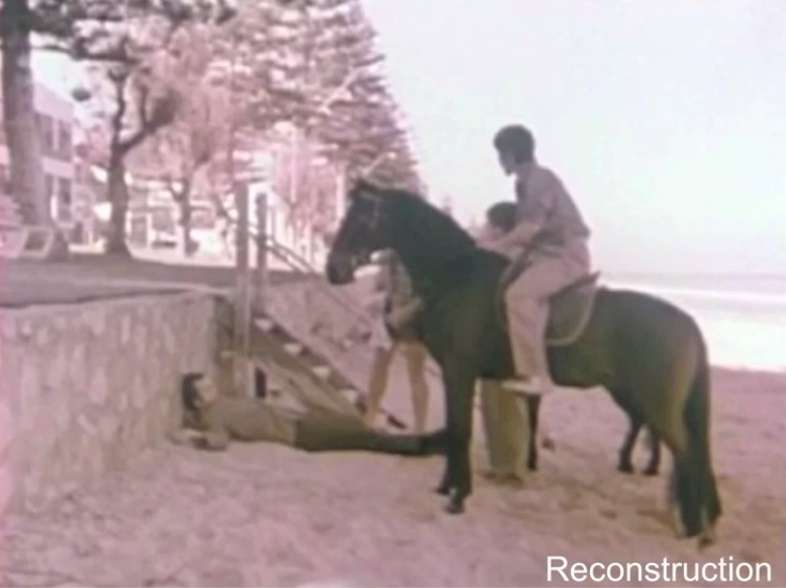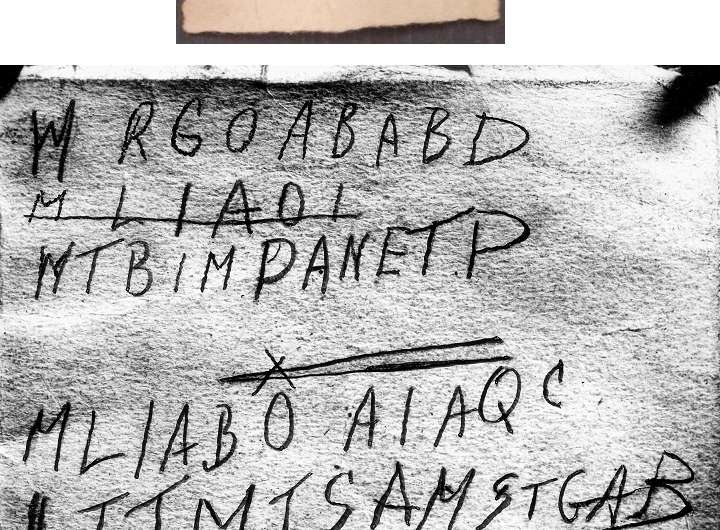June 2, 2015 report
After years of forensic investigation, Somerton Man's identity remains a mystery (Part 1: History and Code)

(Phys.org)—As one of Australia's most infamous cold case mysteries, the enigma of the Somerton Man deals with a haunting situation: a man is found dead on a beach, and no one steps forward to identify him. While it's common for people to go missing and never be found, this case is the opposite: a person's body is found, but no one seems to have missed him.
Who was the Somerton Man, and where did he come from? Many people have been trying to answer these questions for a long time with little success. Recently, investigators have applied the latest forensics science techniques to the case in hopes of finding some answers, although the mystery is still far from being solved.
Over the past few years, one of the principle scientific investigators of the case has been Derek Abbott, a professor of Electrical & Electronic Engineering at the University of Adelaide in Adelaide, Australia, the city in which the incident occurred.
December 1, 1948
At around 6:00 a.m. on Wednesday, December 1, 1948, two horseback riders on Adelaide's Somerton Beach were the first to notice a man's body lying in the sand, his head propped up against the retaining wall near the stairs, and inspect closely enough to confirm that he was indeed dead. The evening before, a few people reported seeing a man "sleeping" in the same location, but suspected that he was drunk. The man had a bus ticket in his pocket that he had bought earlier that day, suggesting that he had arrived at the beach no earlier than that afternoon.
An autopsy revealed that the man was in his early 40s, was physically fit, and had a healthy heart. It found no signs of violence and no poison (cyanides, alkaloids, barbiturates, or carbolic acid) in his system. However, his organs were filled with blood, and his spleen was three times its normal size. Although heart failure was determined to be the immediate cause of death, the cause leading up to heart failure was unknown, and the death was deemed unnatural.
The case received prominent media coverage at the time, and over the next six months, dozens of people came to look at the embalmed body in search of missing friends and relatives, but no one could accurately identify him. The following June, an inquest concluded that both the cause of death and the man's identity were unknown. The body was buried in a graveyard in Adelaide, with a tombstone that reads "Here lies the Unknown Man, who was found at Somerton Beach, 1 Dec. 1948."
Although the case is still considered open by the South Australian Major Crime Task Force, it has largely been forgotten until the past few years when Abbott and other investigators have taken a renewed interest in it, hoping that a combination of modern forensics techniques, old-fashioned detective work, and a little luck may shed some light on the mystery.
For Abbott, the biggest motivating factor in identifying the Somerton Man is somewhat of a moral human principle: even when a person has lost everything, including their life, they should still have their name.

"Governments today sponsor DNA identification of WWI and WWII unmarked graves in order to bring closure to families," Abbott said. "Our individual identities are fundamental to being human, and this is why we are all given names at birth. Civilized societies always strive to preserve the identities of the dead, whether it be the result of accident, crime, war, or natural disaster. Thus there is the social imperative to improve our forensic methods, and apply modern science, to mitigate the ultimate dehumanization: identity loss."
Tamám shud
Perhaps the most unique piece of evidence in the Somerton Man case is a tiny piece of paper found in the man's pocket containing the printed words "Tamám shud," which means "finished" or "ended" in Persian. Sometimes the case is even called the "Tamám shud case." A journalist at the time named Frank Kennedy quickly recognized the paper to be torn from the last page of The Rubáiyát of Omar Khayyám, a book of collected poems by Omar Khayyám, an 11th century Persian poet, mathematician and astronomer. In July 1949, weeks after the inquest ended, a man brought in the exact copy of the book from which the paper was torn, saying that the book had been tossed into his open car window while parked on the street, around the time the corpse was found.
In the back of this book are five lines of letters that appear to be some kind of code. Although many people have tried to decipher it, no one has figured out what the code means, or even proven that it is for sure a code at all. But the fact that this mysterious string of letters exists suggests that the circumstances of the Somerton Man's life may be at least as perplexing as those of his death.
In an attempt to find some answers, Abbott has approached the "code" from many angles, though so far with minimal results. First, to test the hypothesis that the letters are just random jottings, he had a group of students write letters as they randomly came to mind (first sober, then after alcohol), but the results were the same: the letters in the book seem to bear a structure, as they aren't statistically distributed in the way that humans would produce random letters.
Then Abbott and his students tried to see if the letters matched any of the ciphers that were known during World War II. Two of Abbott's students, Stephen Maxwell and Patrick Johnson, won a prestigious award—Australia's 2011 Defence Science and Technology Organisation (DSTO) Surveillance Systems Undergraduate Prize—for eliminating more than 20 types of ciphers. Great investigative work, but disappointing results.
To see if they could statistically match the letters to a language, Abbott and his students compared them to the letters in the Declaration of Human Rights, as it is a large document that has been translated into every extant language in the world. Using an automated approach in software, they found no match to any language. However, when running the test again and limiting it to only the first letters of words, English turned up as the closest match.

At this point, the team is investigating two possibilities: that the letters are either a kind of one-time pad code that exploits initial letters, or that they are simply the first letters of a phrase of English words.
If the letters are a one-time pad code, the code could be deciphered only by knowing the secret key, or "pad." The obvious one-time pad would be something in The Rubáiyát of Omar Khayyam. In the coming months, the researchers plan to use systematic computer searches to check this hypothesis. However, if the one-time pad comes from another book, then it would be all but impossible to ever decipher the code.
To investigate the second possibility, that the code consists of the first letters of a phrase, the researchers built their own search engine that can use "wildcards"—symbols that represent any letter—to search for phrases that begin with these letters. Unfortunately, Google does not offer this wildcard capability. However, the researchers quickly realized that their homemade search engine greatly lagged behind Google in speed.
"Trawling the web with one PC takes an eternity," Abbott explained. "Google has a server farm, and they then index the web, so your searches are on a post-trawled web index. Because you don't actually trawl, your search is blindingly fast.
"To give you an example of how dumb we were, after making a search engine that could use wildcards, we trawled the web looking for any phrases that began with these letters from the code: MLIAB. For just that one short sequence, it took 18 hours just to get one hit. It came up with the phrase 'my love is a butterfly.' We obviously weren't going to try that again, however, interesting that the first hit we got was something of a romantic genre."
Abbott then inquired with Google for permission to access their web index directly, but to no avail. Now the researchers plan to use Google's publicly available N-gram data—vast numbers of phrases that contain up to five words—to further their search. While this approach can never reliably reconstruct the original message, it might deliver clues to the general nature of the message by finding unique phrases that fit the letter sequences.
"Part 2: DNA, isotopes, and autopsy" is here: http://phys.org/news/2015-06-years-forensic-somerton-identity-mystery_1.html.
More information: More information on the Somerton Man:
Reddit thread discussion with Prof. Abbott on the Somerton Man case
Crowdsourcing campaign for research funds, to go toward more sophisticated DNA tests and to pay research assistants to process DNA and isotope data. (The project has so far been done without external funding.)
Change.org petition for the exhumation of the Somerton Man to assist in his identification
The Unknown Man by Gerry Feltus
"The Somerton Man: An Unsolved History" paper by Ruth Balint
Taman Shud: The Somerton Man Mystery by Kerry Greenwood
© 2015 Phys.org




















